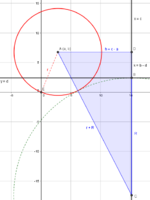You are using an out of date browser. It may not display this or other websites correctly.
You should upgrade or use an alternative browser.
You should upgrade or use an alternative browser.
Locate external point of tangency
- Thread starter gmb
- Start date
Dr.Peterson
Elite Member
- Joined
- Nov 12, 2017
- Messages
- 16,087
Please explain more clearly, in words, what is known and what you want to find. A simple sketch with points labelled will help you refer to items clearly.I am trying to find the intersecting point of tangency between two circles when the smaller is known and the larger lies tangent to a known line.
Dr.Peterson
Elite Member
- Joined
- Nov 12, 2017
- Messages
- 16,087
That doesn't really help a lot; what I meant by "labeled" was that you would name the points and circles so you could talk explicitly about them, or at least identify them in your description in terms of the numbers in the diagram. I'll try to state what I think you are saying.I have one circle with a known radius and center point. Based on this I need to find the point of tangency with respect to a second circle with an unknown Radius that must also be tangent to a line segment.
View attachment 25788
You are given a circle with radius 7 11/32", passing through the origin, whose center is at y = 5 9/16" (from which we can calculate x, so the circle is fully specified). It appears that this given circle also passes through (1 7/32, 7 157/256), so that it is in fact overspecified. Examining that point, it looks like 1 7/32 is really its y-coordinate, not x as you indicate. Also, because I don't find that this point lies on the circle, I'm wondering if the statement "arc center y = 5 9/16" might be giving the height as that far above the other point, rather than the actual y-coordinate, relative to the marked origin. Yes, that makes this point, with coordinates (7.61345, 1.21875) lie on the circle, so things are consistent. I'll suppose I've got that right.
You want to add in a circle whose center is at x = 14 1/2". I don't think you know the location of the point of tangency with the horizontal line, or where that line is. The only other thing you know is that it is tangent to the given circle. You want to find that point of tangency. Am I right?
I'll hold off on trying to work this out (which won't be hard) until you confirm my guesses.
Dr.Peterson
Elite Member
- Joined
- Nov 12, 2017
- Messages
- 16,087
Okay, so you do know the location of the horizontal line, which wasn't indicated before, as well as the vertical line.View attachment 25826
One more go
Given Circle c with center at point A (passes thru the origin)
Find Center Point B of Circle d which lies on line g, when tangent to both line f and Circle c.
B=(15.23,-16.7) approximately
I let a = 2.82, b = 6.78, so A = (a, b); and c = 15.23, d = 2.44, so the lines are x = c and y = d. The given radius is \(r=\sqrt{a^2+b^2}\).
The following picture gives us a right triangle we can use to make a formula for the desired radius, R:

The Pythagorean Theorem tells us that \(h^2 +(k+R)^2=(r+R)^2\). Solving this for R, I get \(R=\frac{h^2+k^2-r^2}{2(r-k)}\).
(I constructed the picture using the formula for R, to make sure it works. My C is at (15.23, -17.39).)



